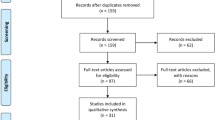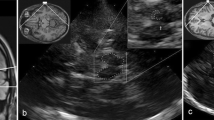Abstract
During the past two decades, transcranial sonography (TCS) has developed to an increasingly used brain imaging method that visualizes characteristic patterns of basal ganglia alterations in distinct movement disorders. Since the discovery of a characteristic abnormal hyperechogenic appearance of substantia nigra (SN) on TCS in Parkinson’s disease (PD), which is stable during the course of the disease and probably present already in preclinical disease stages, the results of several studies have promoted the idea that this TCS finding in healthy subjects might be a risk marker of PD. The present view summarizes current scientific evidence favouring the idea that the TCS finding of SN hyperechogenicity alone may not be a (strong) risk marker of PD. Especially, it is discussed how reliable this TCS finding is, whether this TCS finding can be regarded as a progression marker or a risk marker of PD, how strongly it may indicate a risk of PD, what else if not an increased risk of PD could be indicated, and which role TCS of SN may finally play in the detection of subjects at risk of PD.
Similar content being viewed by others
References
Becker G, Seufert J, Bogdahn U, Reichmann H, Reiners K (1995) Degeneration of substantia nigra in chronic Parkinson’s disease visualized by transcranial color-coded real-time sonography. Neurology 45:182–184
Behnke S, Double KL, Duma S, Broe GA, Guenther V, Becker G, Halliday GM (2007) Substantia nigra echomorphology in the healthy very old: correlation with motor slowing. Neuroimage 34:1054–1059
Behnke S, Schroeder U, Dillmann U, Buchholz HG, Schreckenberger M, Fuss G, Reith W, Berg D, Krick CM (2009) Hyperechogenicity of the substantia nigra in healthy controls is related to MRI changes and to neuronal loss as determined by F-Dopa PET. Neuroimage 47:1237–1243
Berg D (2007a) Disturbance of iron metabolism as a contributing factor to SN hyperechogenicity in Parkinson’s disease: implications for idiopathic and monogenetic forms. Neurochem Res 32:1646–1654
Berg D (2007b) Ultrasound in the (premotor) diagnosis of Parkinson’s disease. Parkinsonism Relat Disord 13(Suppl 3):S429–S433
Berg D, Becker G, Zeiler B, Tucha O, Hofmann E, Preier M, Benz P, Jost W, Reiners K, Lange KW (1999) Vulnerability of the nigrostriatal system as detected by transcranial ultrasound. Neurology 53:1026–1031
Berg D, Siefker C, Ruprecht-Dörfler P, Becker G (2001a) Relationship of substantia nigra echogenicity and motor function in elderly subjects. Neurology 56:13–17
Berg D, Jabs B, Merschdorf U, Beckmann H, Becker G (2001b) Echogenicity of substantia nigra determined by transcranial ultrasound correlates with severity of parkinsonian symptoms induced by neuroleptic therapy. Biol Psychiatry 50:463–467
Berg D, Siefker C, Becker G (2001c) Echogenicity of the substantia nigra in Parkinson’s disease and its relation to clinical findings. J Neurol 8:684–689
Berg D, Merz B, Reiners K, Naumann M, Becker G (2005) Five-year follow-up study of hyperechogenicity of the substantia nigra in Parkinson’s disease. Mov Disord 20:383–385
Berg D, Godau J, Walter U (2008) Transcranial sonography in movement disorders. Lancet Neurol 7:1044–1055
Bernheimer H, Birkmayer W, Hornykiewicz O, Jellinger K, Seitelberger F (1973) Brain dopamine and the syndromes of Parkinson and Huntington. Clinical, morphological and neurochemical correlations. J Neurol Sci 20:415–455
Birkmayer W, Hornykiewicz O (1962) Der l-Dioxyphenylalanin (l-DOPA)-Effekt beim Parkinson-Syndrom des Menschen: Zur Pathogenese und Behandlung der Parkinson-Akinese. Arch Psychiatr Nervenkr Z Gesamte Neurol Psychiatr 203:560–574
Budisić M, Trkanjec Z, Bosnjak J, Lovrencić-Huzjan A, Vuković V, Demarin V (2009) Distinguishing Parkinson’s disease and essential tremor with transcranial sonography. Acta Neurol Scand 119:17–21
Doepp F, Plotkin M, Siegel L, Kivi A, Gruber D, Lobsien E, Kupsch A, Schreiber SJ (2008) Brain parenchyma sonography and 123I-FP-CIT SPECT in Parkinson’s disease and essential tremor. Mov Disord 23:405–410
Fearnley JM, Lees AJ (1991) Ageing and Parkinson’s disease: substantia nigra regional selectivity. Brain 114:2283–2301
Frigerio R, Fujishiro H, Maraganore DM, Klos KJ, DelleDonne A, Heckman MG, Crook JE, Josephs KA, Parisi JE, Boeve BF, Dickson DW, Ahlskog JE (2009) Comparison of risk factor profiles in incidental Lewy body disease and Parkinson disease. Arch Neurol 66:1114–1119
Greffard S, Verny M, Bonnet AM, Beinis JY, Gallinari C, Meaume S, Piette F, Hauw JJ, Duyckaerts C (2006) Motor score of the Unified Parkinson Disease Rating Scale as a good predictor of Lewy body-associated neuronal loss in the substantia nigra. Arch Neurol 63:584–588
Hagenah JM, König IR, Becker B, Hilker R, Kasten M, Hedrich K, Pramstaller PP, Klein C, Seidel G (2007) Substantia nigra hyperechogenicity correlates with clinical status and number of Parkin mutated alleles. J Neurol 254:1407–1413
Hagenah J, König IR, Sperner J, Wessel L, Seidel G, Condefer K, Saunders-Pullman R, Klein C, Brüggemann N (2010) Life-long increase of substantia nigra hyperechogenicity in transcranial sonography. Neuroimage 51:28–32
Hirsch EC (2006) Altered regulation of iron transport and storage in Parkinson’s disease. J Neural Transm 71(Suppl):201–204
Hirsch E, Graybiel AM, Agid YA (1988) Melanized dopaminergic neurons are differentially susceptible to degeneration in Parkinson’s disease. Nature 334:345–348
Hoeppner J, Prudente-Morrissey L, Herpertz SC, Benecke R, Walter U (2009) Substantia nigra hyperechogenicity in depressive subjects relates to motor asymmetry and impaired word fluency. Eur Arch Psychiatry Clin Neurosci 259:92–97
Huang YW, Jeng JS, Tsai CF, Chen LL, Wu RM (2007) Transcranial imaging of substantia nigra hyperechogenicity in a Taiwanese cohort of Parkinson’s disease. Mov Disord 22:550–555
Jenner P (1992) What process causes nigral cell death in Parkinson’s disease? Neurol Clin 10:387–403
Kim JY, Kim ST, Jeon SH, Lee WY (2007) Midbrain transcranial sonography in Korean patients with Parkinson’s disease. Mov Disord 22:1922–1926
Kolevski G, Petrov I, Petrova V (2007) Transcranial sonography in the evaluation of Parkinson disease. J Ultrasound Med 26:509–512
Krauel K, Feldhaus HC, Simon A, Rehe C, Glaser M, Flechtner HH, Heinze HJ, Niehaus L (2010) Increased echogenicity of the substantia nigra in children and adolescents with attention-deficit/hyperactivity disorder. Biol Psychiatry 68:352–358
Mijajlović M, Dragasević N, Stefanova E, Petrović I, Svetel M, Kostić VS (2008) Transcranial sonography in spinocerebellar ataxia type 2. J Neurol 255:1164–1167
Okawa M, Miwa H, Kajimoto Y, Hama K, Morita S, Nakanishi I, Kondo T (2007) Transcranial sonography of the substantia nigra in Japanese patients with Parkinson’s disease or atypical parkinsonism: clinical potential and limitations. Intern Med 46:1527–1531
Parent M, Parent A (2010) Substantia nigra and Parkinson’s disease: a brief history of their long and intimate relationship. Can J Neurol Sci 37:313–319
Postert T, Lack B, Kuhn W, Jergas M, Andrich J, Braun B, Przuntek H, Sprengelmeyer R, Agelink M, Büttner T (1999) Basal ganglia alterations and brain atrophy in Huntington’s disease depicted by transcranial real time sonography. J Neurol Neurosurg Psychiatry 67:457–462
Ressner P, Skoloudík D, Hlustík P, Kanovský P (2007) Hyperechogenicity of the substantia nigra in Parkinson’s disease. J Neuroimaging 17:164–167
Rhodes SL, Ritz B (2008) Genetics of iron regulation and the possible role of iron in Parkinson’s disease. Neurobiol Dis 32:183–195
Riederer P, Wuketich S (1976) Time course of nigrostriatal degeneration in Parkinson’s disease. A detailed study of influential factors in human brain amine analysis. J Neural Transm 38:277–301
Ruprecht-Dörfler P, Klotz P, Becker G, Berg D (2007) Substantia nigra hyperechogenicity correlates with subtle motor dysfunction in tap dancers. Parkinsonism Relat Disord 13:362–364
Saunders-Pullman R, Stanley K, Brüggemann N, Raymond D, San Luciano M, Wang C, Klein C, Lubarr N, Ozelius L, Bressman SB, Hagenah J (2010) Substantia nigra hyperechogenicity in DYT6 dystonia: a pilot study. Parkinsonism Relat Disord 16:420–422
Schmidauer C, Sojer M, Seppi K, Stockner H, Högl B, Biedermann B, Brandauer E, Peralta CM, Wenning GK, Poewe W (2005) Transcranial ultrasound shows nigral hypoechogenicity in restless legs syndrome. Ann Neurol 58:630–634
Schweitzer KJ, Hilker R, Walter U, Burghaus L, Berg D (2006) Substantia nigra hyperechogenicity as a marker of predisposition and slower progression in Parkinson’s disease. Mov Disord 21:94–98
Skoloudík D, Fadrná T, Bártová P, Langová K, Ressner P, Zapletalová O, Hlustík P, Herzig R, Kannovský P (2007) Reproducibility of sonographic measurement of the substantia nigra. Ultrasound Med Biol 33:1347–1352
Snyder AM, Connor JR (2009) Iron, the substantia nigra and related neurological disorders. Biochim Biophys Acta 1790:606–614
Sommer U, Hummel T, Cormann K, Mueller A, Frasnelli J, Kropp J, Reichmann H (2004) Detection of presymptomatic Parkinson’s disease: combining smell tests, transcranial sonography, and SPECT. Mov Disord 19:1196–1202
Spiegel J, Behnke S, Fuss G, Becker G, Dillmann U (2005) Echogenic substantia nigra in patients with orthostatic tremor. J Neural Transm 112:915–920
Spiegel J, Hellwig D, Möllers MO, Behnke S, Jost W, Fassbender K, Samnick S, Dillmann U, Becker G, Kirsch CM (2006) Transcranial sonography and [123I]FP-CIT SPECT disclose complementary aspects of Parkinson’s disease. Brain 129:1188–1193
Stockner H, Sojer M, KS K, Mueller J, Wenning GK, Schmidauer C, Poewe W (2007) Midbrain sonography in patients with essential tremor. Mov Disord 22:414–417
Stockner H, Iranzo A, Seppi K, Serradell M, Gschliesser V, Sojer M, Valldeoriola F, Molinuevo JL, Frauscher B, Schmidauer C, Santamaria J, Högl B, Tolosa E, Poewe W, SINBAR (Sleep Innsbruck Barcelona) Group (2009) Midbrain hyperechogenicity in idiopathic REM sleep behavior disorder. Mov Disord 24:1906–1909
Tsai CF, Wu RM, Huang YW, Chen LL, Yip PK, Jeng JS (2007) Transcranial color-coded sonography helps differentiation between idiopathic Parkinson’s disease and vascular parkinsonism. J Neurol 254:501–507
Unger MM, Möller JC, Stiasny-Kolster K, Mankel K, Berg D, Walter U, Hoeffken H, Mayer G, Oertel WH (2008) Assessment of idiopathic rapid-eye-movement sleep behavior disorder by transcranial sonography, olfactory function test, and FP-CIT-SPECT. Mov Disord 23:596–599
van de Loo S, Walter U, Behnke S, Hagenah J, Lorenz M, Sitzer M, Hilker R, Berg D (2010) Reproducibility and diagnostic accuracy of substantia nigra sonography for the diagnosis of Parkinson’s disease. J Neurol Neurosurg Psychiatry 81:1087–1092
Walter U (2009) Transcranial brain sonography findings in Parkinson’s disease: implications for pathogenesis, early diagnosis and therapy. Expert Rev Neurother 9:835–846
Walter U, Wittstock M, Benecke R, Dressler D (2002) Substantia nigra echogenicity is normal in non-extrapyramidal cerebral disorders but increased in Parkinson’s disease. J Neural Transm 109:191–196
Walter U, Klein C, Hilker R, Benecke R, Pramstaller PP, Dressler D (2004a) Brain parenchyma sonography detects preclinical parkinsonism. Mov Disord 19:1445–1449
Walter U, Dressler D, Wolters A, Probst T, Grossmann A, Benecke R (2004b) Sonographic discrimination of corticobasal degeneration vs progressive supranuclear palsy. Neurology 63:504–509
Walter U, Krolikowski K, Tarnacka B, Benecke R, Czlonkowska A, Dressler D (2005) Sonographic detection of basal ganglia lesions in asymptomatic and symptomatic Wilson disease. Neurology 64:1726–1732
Walter U, Dressler D, Wolters A, Wittstock M, Greim B, Benecke R (2006) Sonographic discrimination of dementia with Lewy bodies and Parkinson’s disease with dementia. J Neurol 253:448–454
Walter U, Behnke S, Eyding J, Niehaus L, Postert T, Seodel G, Berg D (2007a) Transcranial brain parenchyma sonography in movement disorders: state of the art. Ultrasound Med Biol 33:15–25
Walter U, Hoeppner J, Prudente-Morrissey L, Horowski S, Herpertz SC, Benecke R (2007b) Parkinson’s disease-like midbrain sonography abnormalities are frequent in depressive disorders. Brain 130:1799–1807
Walter U, Dressler D, Wolters A, Wittstock M, Benecke R (2007c) Transcranial brain sonography findings in clinical subgroups of idiopathic Parkinson’s disease. Mov Disord 22:48–54
Walter U, Dressler D, Probst T, Wolters A, Abu-Mugheisib M, Wittstock M, Benecke R (2007d) Transcranial brain sonography findings in discriminating between parkinsonism and idiopathic Parkinson disease. Arch Neurol 64:1635–1640
Walter U, Kanowski M, Kaufmann J, Grossmann A, Benecke R, Niehaus L (2008) Contemporary ultrasound systems allow high-resolution transcranial imaging of small echogenic deep intracranial structures similarly as MRI: a phantom study. Neuroimage 40:551–558
Walter U, Wagner S, Horowski S, Benecke R, Zettl UK (2009) Transcranial brain sonography findings predict disease progression in multiple sclerosis. Neurology 73:1010–1017
Weise D, Lorenz R, Schliesser M, Schirbel A, Reiners K, Classen J (2009) Substantia nigra echogenicity: a structural correlate of functional impairment of the dopaminergic striatal projection in Parkinson’s disease. Mov Disord 24:1669–1675
Author information
Authors and Affiliations
Corresponding author
Rights and permissions
About this article
Cite this article
Walter, U. Substantia nigra hyperechogenicity is a risk marker of Parkinson’s disease: no. J Neural Transm 118, 607–612 (2011). https://doi.org/10.1007/s00702-010-0564-7
Received:
Accepted:
Published:
Issue Date:
DOI: https://doi.org/10.1007/s00702-010-0564-7




